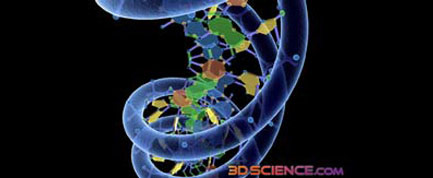Genes: The Instruction Manuals for Life

A gene is a how-to book for making one product—a protein.
Proteins perform most life functions, and make up almost all cellular structures. Genes control everything from hair color to blood sugar by telling cells which proteins to make, how much, when, and where.
Genes exist in most cells. Inside a cell is a long strand of the chemical DNA (deoxyribonucleic acid). A DNA sequence is a specific lineup of chemical base pairs along its strand. The part of DNA that determines what protein to produce and when, is called a gene.
Inside genes
The term gene, first created by Danish botanist Wilhelm Johannsen in 1909, comes from the Greek word for origin, genos.
The number of genes in an organism's complete set of DNA, called a genome, varies from species to species. More complex organisms have more genes. A virus has a few hundred genes. Honeybees have about 15,000 genes. Scientists estimate that humans have around 25,000 genes.
Each gene has many parts. The protein-making instructions come from short sections called exons. Longer "nonsense" DNA, known as introns, flank the exons. Genes also include regulatory sequences. Although scientists don't fully understand their function, regulatory sequences help turn genes on.
Get the world’s most fascinating discoveries delivered straight to your inbox.
Each gene helps determine different characteristics of an individual, such as nose shape. Full of information, genes pass similar traits from one generation to the next. That's how your cousin inherited grandpa's nose.
Peas in a pod
The "Father of Genetics," Gregor Mendel, was an Austrian monk who experimented with plants growing in his monastery. He studied inheritance in pea plants during the 1860s.
Mendel observed that when he bred plants that had green pea pods with plants that had yellow pea pods, all of the offspring had green pods. When Mendel bred the second generation with one another, some of the baby pods had green pods and some had yellow pods.
He discovered that a trait, or phenotype, could disappear in one generation and could reappear in a future generation.
Individuals have two copies of each gene, one inherited from each parent. Mendel explained how these copies interact to determine which trait is expressed.
In all peas there is a gene for pod color. The pod color gene has green and yellow versions, or alleles. Mendel's green pod alleles are dominant, and the yellow pod alleles are recessive. In order to express a recessive form of the trait (yellow), individuals must inherit recessive alleles from both parents.
A plant that inherits one green allele and one yellow allele will be green. But it can still pass the recessive yellow allele onto its offspring. That's how some of Mendel's pea pods came out yellow.
More to it
Human diseases such as sickle cell anemia are passed down in a similar way.
However, genetics don't always work so simply. Most genetics and instances of heredity are more complex than what Mendel saw in his garden.
It often takes more than a single gene to dictate a trait; and one gene can make instructions for more than trait. The environment, from the weather outside to an organism's body chemistry, plays a large role in dictating traits too.
Related Stories
